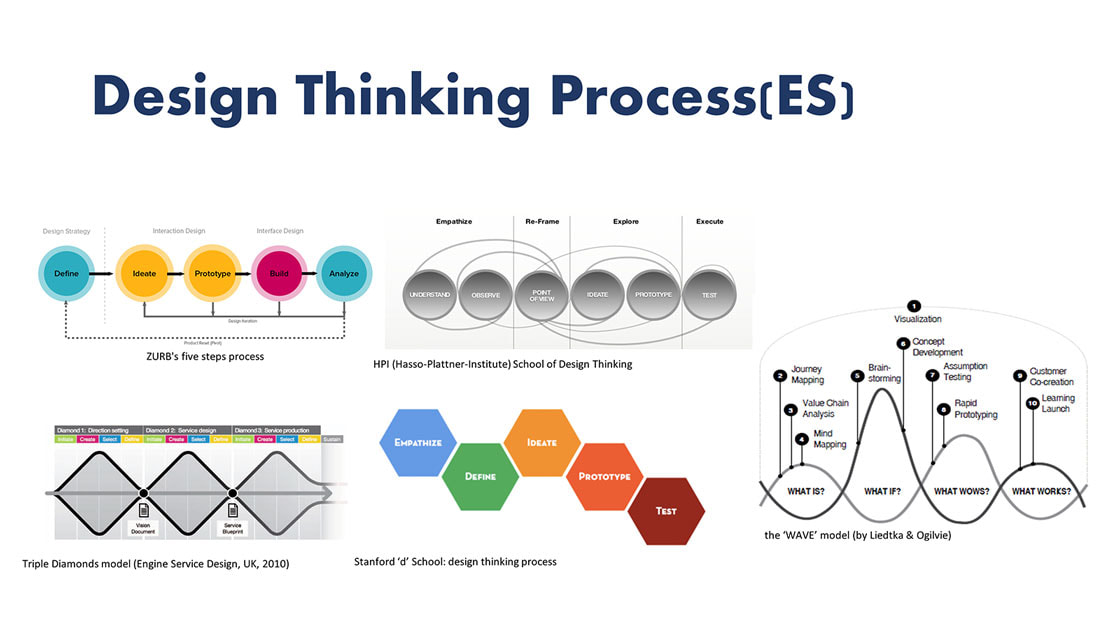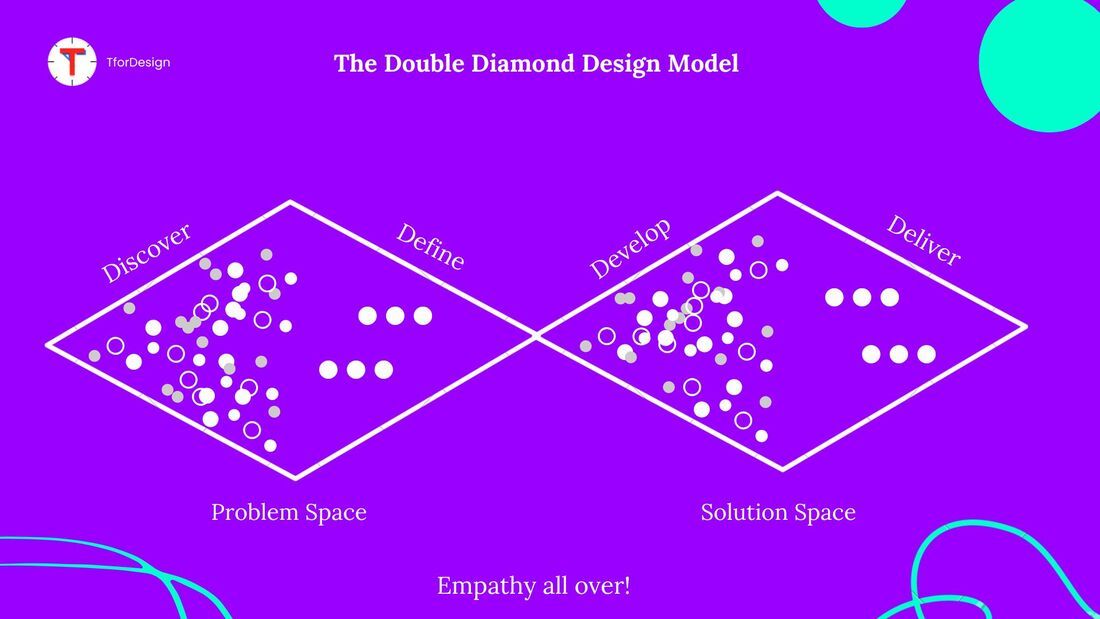What is Design Thinking?
Design Thinking is an innovation process/framework that puts human needs at the center of the problem-solving approach. It is one of the most prominent innovation processes out there that has been gaining considerable buzz.
Currently, there are many different forms and shapes of the design thinking process. Those include the WAVE model by Liedtka & Ogilvie, the Stanford 'd' School Design Thinking process, ZURB's five steps process, the double diamond model by the British design console, and the triple diamonds model. by the Engine Service Design. Our go-to process is the double diamond process which has the stages: Discover, Define, Develop, and Deliver. We'll talk more about this process below.
Currently, there are many different forms and shapes of the design thinking process. Those include the WAVE model by Liedtka & Ogilvie, the Stanford 'd' School Design Thinking process, ZURB's five steps process, the double diamond model by the British design console, and the triple diamonds model. by the Engine Service Design. Our go-to process is the double diamond process which has the stages: Discover, Define, Develop, and Deliver. We'll talk more about this process below.
Under each of those stages, there are many different tools and methods used to establish them. Those can include empathy mapping, lifestyle research, prototyping methods, etc. When presented, the stages look linear. However, that is not the case in practice. Practicing design thinking to solve problems can be messy and often requires jumping back and forth between stages as more realizations get uncovered.
What is the Root of Design Thinking?
Behind the Design Thinking process is a fundamental mindset of design that puts a strong emphasis on human needs. One easy mean to incorporate Design Thinking in your work is to focus on the human perspective in every endeavor. This can be done by continuously asking the question: “What are the human needs behind (the action, feature, etc.)?”
Now we have a simple idea of Design Thinking, let us dive deeper into what Design Thinking is all about.
Now we have a simple idea of Design Thinking, let us dive deeper into what Design Thinking is all about.
A Brief History of Design Thinking.
While 'Design Thinking' has been popularized in the last century, the origins of it existed a long time ago as a method of problem-solving.
The origins of design thinking can be traced back to the 1950s and 1960s, with foundations in the study of design cognition and design methods. The term "design thinking" has been used to reflect a specific way of thinking, a general theory of design, and a set of resources for learning. One of the key facets of design thinking is its non-linear, iterative process, which includes activities such as context analysis, problem finding and framing, ideation and solution generation, sketching and drawing, prototyping, and evaluating.
Design thinking was first thoroughly outlined in notable books that were published during the 1960s, among them "The Sciences of the Artificial" by Herbert A. Simon (1969) and "Applied Imagination: Principles and Procedures of Creative Problem-Solving" by Alex Faickney Osborn (1963). These early works helped establish design thinking as a systematically applied problem-solving method that broke away from traditional linear approaches.
Over time, design thinking has further evolved, focusing on the co-evolution of problem and solution, and the critical role of representations and modeling. It is now often viewed less as a sequence of orderly steps and more as a system of overlapping spaces - inspiration, ideation, and implementation.
The origins of design thinking can be traced back to the 1950s and 1960s, with foundations in the study of design cognition and design methods. The term "design thinking" has been used to reflect a specific way of thinking, a general theory of design, and a set of resources for learning. One of the key facets of design thinking is its non-linear, iterative process, which includes activities such as context analysis, problem finding and framing, ideation and solution generation, sketching and drawing, prototyping, and evaluating.
Design thinking was first thoroughly outlined in notable books that were published during the 1960s, among them "The Sciences of the Artificial" by Herbert A. Simon (1969) and "Applied Imagination: Principles and Procedures of Creative Problem-Solving" by Alex Faickney Osborn (1963). These early works helped establish design thinking as a systematically applied problem-solving method that broke away from traditional linear approaches.
Over time, design thinking has further evolved, focusing on the co-evolution of problem and solution, and the critical role of representations and modeling. It is now often viewed less as a sequence of orderly steps and more as a system of overlapping spaces - inspiration, ideation, and implementation.
Why Should You Apply Design Thinking?
One question you might be asking yourself is why should you or your organization care about Design Thinking. Let us explore a few points to help answer this.
- Design Thinking Drives Customer-Centricity: Design Thinking is important for organizations as it drives innovation and fosters a customer-centric approach. It provides a structured process that helps businesses understand their customers' needs more thoroughly, pushing problem-solving to revolve around customers' perspectives. This leads ultimately to the development of products or services that are directly tailored towards and valued by the users which ultimately result in a competitive advantage.
- Design Thinking is About Finding Solutions: Design Thinking lies in its solution-based approach, which encourages organizations to envision and create a future that addresses users' needs, rather than simply addressing existing problems. This disruptive way of thinking often leads to groundbreaking products and services, providing businesses with a competitive edge in the market.
- Design Thinking Cultivates Collaboration and Empathy: Design Thinking creates a culture of collaboration and empathy within the organization. The active involvement of various stakeholders, including employees from different departments, customers, and even business partners, in the Design Thinking process encourages cross-functional collaboration and knowledge sharing. This gives rise to diverse ideas and holistic solutions, enhancing the organization's capacity for innovation and problem-solving.
- Design Thinking is All About Becoming Better: Since Design Thinking is an iterative process, it promotes learning from failure, quick adaptation, and constant improvement within an organization. The iterative nature of Design Thinking – involving prototyping and testing – diminishes the fear of failure and rather makes it a part of the learning and improving cycle. This approach saves organizations valuable time and resources in the long run.
Why Can Adapting Design Thinking Be Challenging?
It is important to understand that Design Thinking is first a mindset, then a set of tools and approaches that can support that mindset. This brings about its biggest challenge, a lack of Empathy and a Customer-Centric Mindset. Design Thinking requires genuine empathy toward users and an understanding of their needs. Organizations might struggle with fully understanding their customers’ perspectives or have a dominant internal focus that prioritizes organizational objectives over customers' needs.
Here are some of the other major challenges you might be facing on your journey to applying Design Thinking in your organization.
- Insufficient Time and Resources: Design Thinking can be time-consuming and resource-intensive, especially in its initial stages. Organizations might find it challenging to allocate appropriate resources and dedicate sufficient time for user research, ideation, prototyping, and testing.
- Inadequate Leadership Support: For Design Thinking to thrive, strong leadership support and commitment are essential. Without buy-in from top management, organizations might struggle to implement change and allocate necessary resources. This is especially the case for organization-wide mindset shifts in traditionally top-down organizations.
- Ineffective Facilitation: This is more for organizations who are starting out in their Design Thinking journey. Design Thinking sessions require skilled facilitators to guide and manage the process effectively. Inadequate facilitation skills might lead to unproductive discussions, poor ideas generation, and limited engagement among participants.
- Overemphasis on Tools and Techniques: Organizations might focus too much on learning and applying specific Design Thinking tools and techniques, overshadowing the critical aspects of empathy, ideation, and iteration. Ensuring a balance between mastering tools and embracing the mindset is crucial for the approach’s success. This is with the rise of what we like to refer to as process-fundamentalism. This is why we often advise practitioners to skip the fancy terms and take it easy on applied processes and tools.
What is The Double-Diamond Design Process?
While there are many frameworks and models for Design Thinking, our favorite one is the Double-Diamond Design process. The Double Diamond design process is a visual framework introduced by the UK Design Council in 2005. It is used for graphically illustrating the design process. Divided into four distinct phases – Discover, Define, Develop, and Deliver – it employs divergent thinking to explore possibilities and convergent thinking to sharpen the focus and deliver solutions. This dual approach facilitates the creation of impactful, user-centric solutions in response to complex challenges.
Phases of the Double-Diamond Design Process:
- Discover: This phase involves broadening the understanding of the problem by conducting research, gathering insights, and exploring the design space. Divergent thinking is used to explore and understand user needs, market dynamics, and technology trends.
- Define: This phase involves synthesizing all the insights and findings from the discovery phase to define a clear and actionable problem statement. The aim is to converge on the right problem to solve.
- Develop: This phase focuses on generating a wide range of potential solutions to the defined problem using various ideation techniques. This is another divergent phase where creative solutions are developed, prototyped, and tested.
- Deliver: The last phase is about delivering the final solution. It involves converging on the most effective solution and refining it based on user feedback, prototyping, and testing until it is ready for production and launch.
What are Design Thinking Toolkits?
While the double diamond design process puts a broad framework on the design process, design tools, and frameworks are what are used to turn that broad framework into more tangible insights and actions. We refer to our list of tools as our toolkit. It is very common for different designers and design studios to have their own toolkits they often get back to. It is also common for designers to invent new frameworks to tackle different problem situations. Here is a list of some common tools we use in so specific order.
Here you have it, a little crash course on Design Thinking. We love chatting about Design, feel free to drop us a line and we can get the conversation going. We can help you plan a Design Thinking workshop, develop a Design Thinking curriculum, or provide consultation over your innovation projects.
- Customer journey mapping: A visual representation of every experience your customers have with your brand.
- 5 Whys: A questioning technique for getting to the root cause of a problem.
- Interviews: Methods for collecting qualitative data through individual interviews and group discussions.
- Observations: A method for gathering information about user behavior in real-life situations.
- Innovation Tournaments: a structured process where multiple ideas compete in various stages, going through a series of filters and modifications, to end up with a single or a few exceptional opportunities.
- Desk Research: a collection of information on the project’s theme from different sources: websites, books, magazines, blogs, articles, etc.
- Shadowing: Monitoring a user over a period that includes their interaction with the product or service under analysis.
- Empathy Maps: A visual tool that analyzes and describes behavioral aspects of the ideal customer.
- Reframing: Examining unanswered questions in a company from different perspectives.
Here you have it, a little crash course on Design Thinking. We love chatting about Design, feel free to drop us a line and we can get the conversation going. We can help you plan a Design Thinking workshop, develop a Design Thinking curriculum, or provide consultation over your innovation projects.
More Stuff to Look Into!
What is Design Innovation? An Overview.
Do Employees Hate Innovation?
What Happens After the Design Thinking Workshop?
How to Build a Prototyping Strategy?
Why is Innovation So Important?


